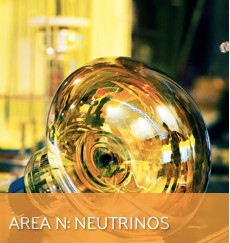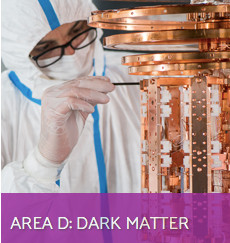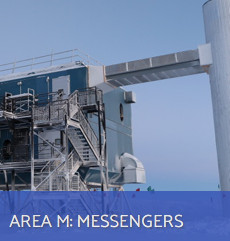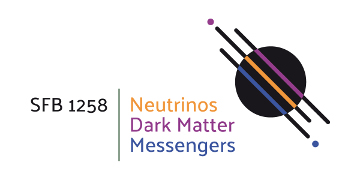The SFB1258 research program
The research focus of the SFB 1258 "Neutrinos and dark matter in astro- and particle physics" lies at the crossroads of particle physics, astrophysics and nuclear physics. It concerns neutrinos, the most abundant matter particles of our universe, and dark matter, that has been driving the dynamics of the universe at galactic scales and beyond. Recent experimental results have propelled our understanding of this interdisciplinary research field to a new level, but key fundamental questions are yet to be answered.
We are a constellation of physicists and astronomers in the Garching-Munich area carrying out research on different aspects of neutrinos and dark matter. To tackle these key fundamental questions, we have joined our forces in the proposed SFB. By combining our expertise, we will advance our scientific understanding of neutrinos (area N), dark matter (area D) and cosmic messengers (area M) by multidisciplinary approaches.
Deciphering the fundamental properties of neutrinos

While our comprehension of the neutrino has changed dramatically over the past decades, some of its fundamental properties are yet to be deciphered, notably if neutrinos are their own antiparticles and whether they have sterile counterparts. Unraveling the neutrino nature would shed light on the question as to why our world was made with more matter than antimatter and therefore why we exist. The determination of and the anticipated discovery of a new elementary particle, the sterile neutrino, would be transformative for our field. During the first funding period, we will focus on measurements with KATRIN and SOX experiments and on theoretical studies. Moreover, we propose to shape the technology for a next generation double beta decay experiment during the subsequent funding period.
Hunting for dark matter particles

One of the most fundamental questions in modern physics is the intrinsic nature of the matter content of the universe. Only a small amount of it - 5 % - is made of the visible matter like stars, galaxies, dust and gas. The rest is composed of dark matter and dark energy, the nature of which remains unknown. Within this SFB, we focus on the hunt for dark matter particles. These include the general class of weakly interacting massive particles (WIMPs), axions and sterile neutrinos. We pursue this task with different strategies, including direct detection with the future CRESST-III experiment, indirect detection approaches with IceCube, new theoretical tools to study quantum effects in the production or detection for heavy WIMPs and the search for phenomenological signatures at the Large Hadron Collider at CERN in Geneva.
Searching for cosmic neutrino sources

Cosmic neutrinos, as new astrophysical messengers, are opening a new window towards the observation of the violent parts of our universe. They allow us to explore phenomena in cosmic accelerators and collapsing stars, not accessible otherwise. IceCube at the South Pole is currently our main observatory, whereas the nascent JUNO detector in China will complement the survey at a later stage. We will seek astrophysical counterparts, such as blazers and gamma-ray bursts to explain the cosmic neutrino emission that has been observed by IceCube. Beyond that, we will also prepare for the observation of the next Galactic core-collapse supernova and for the diffuse supernova neutrino background focusing on the state-of-the-art molding of supernova explosions, including the relevant particle and nuclear physics elements.
Discoveries are within reach
During the next five years, major breakthroughs are within reach. New discoveries can be made within our proposed experimental and theoretical program, including the detection of dark matter particles, sterile neutrinos or neutrinoless double beta decay. New theoretical developments in these and related areas will address fundamental differences between quarks and leptons and the matter-antimatter asymmetry in the universe. In neutrino astronomy, observing events in association with cosmic accelerators or the time profile of a Galactic supernova will profoundly advance our understanding of the nature and mechanisms of cataclysmic events.


